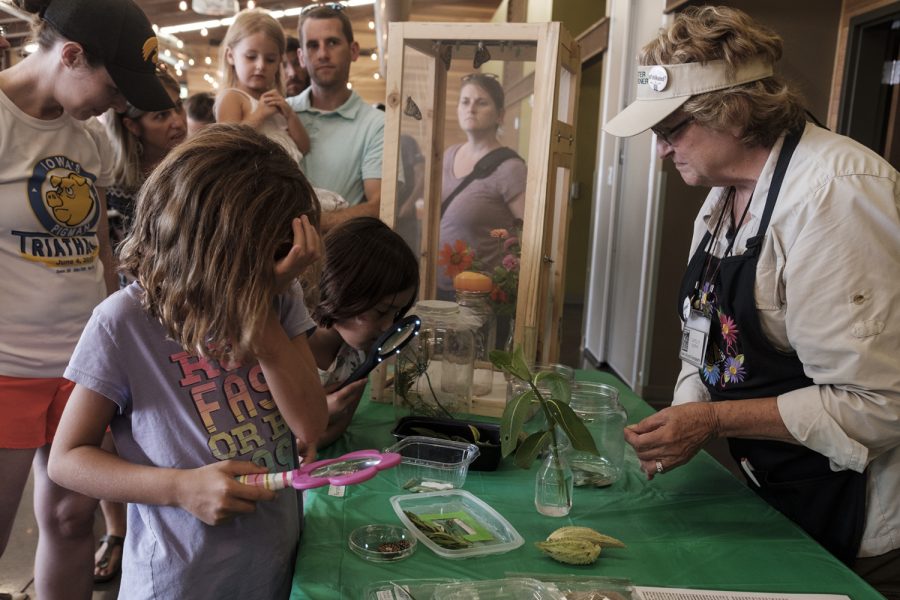Monarch festival celebrates, advocates for famous vanishing butterfly
The third annual Iowa City Monarch Festival included children’s games, live insects, and a wealth of information on how the monarch can make a resurgence.
Johnson County Master Gardener explains samples of different butterflies and their corresponding caterpillars during the third annual Monarch Butterfly Festival at the Terry Trueblood Recreation Area on Sunday, August 26, 2018. The festival featured a variety of butterfly themed educational activities.Johnson County Master Gardener Corolyn Murphy explains samples of different butterflies and their corresponding caterpillars during the third annual Monarch Butterfly Festival at the Terry Trueblood Recreation Area on Sunday, August 26, 2018. The festival featured a variety of butterfly themed educational activities. Murphy specializes in cultivating a garden that creates a favorable habitat for butterflies.
August 26, 2018
One famous butterfly took center stage at the third-annual Iowa City Monarch Festival on Sunday, showcasing Iowa City contributions to prevent the iconic insect from a slide toward endangerment.
“People tend to love the insects they know. As a species, [the monarch] is recognizable, it’s large and beautiful, and during one time of the year, you see a lot of them,” said Nathan Brockman, the curator of the Christina Reiman Butterfly Wing at Reiman Gardens.
The Monarch Festival took place at the Terry Trueblood Recreation Area on Sunday. There were hundreds of attendees and plenty of activities.
Children participated in painting faces, creating origami butterflies, and enjoying butterfly-shaped crackers. Informational tables for groups such as the Iowa Master Naturalists and the Bur Oak Land Trust were also featured.
Live butterflies and caterpillars were featured, as well.
Monarch Festivals have been held in Iowa City since Mayor Jim Throgmorton signed the National Wildlife Federation’s Mayor’s Monarch Pledge in 2016.
Brockman held a presentation called “Monarchs and More” at the Iowa City Public Library on Aug. 24 in conjunction with the Monarch Festival.
As part of his presentation, Brockman brought along a few monarch caterpillars in various growth stages for attendees to look at and interact with. He said monarchs are just one of more than 120 species of butterflies that live in Iowa.
Brockman gave tips on how to best create an environment for butterflies and other insects.
“When you can, use [native plants]. For butterflies, use single clusters of the same plant, because they have to learn how to feed,” he said. “Small butterflies tend to go for smaller flowers, and big butterflies can feed from bigger flowers. [Use] different shapes, all season flowers … short flowers for things on the ground, tall flowers for things that fly around.”
Other topics Brockman touched upon included the distinctions between male and female monarchs, the distribution of the species worldwide, factors determining monarch migration, and how caterpillars morph into butterflies.
Monarchs winter in large colonies in Mexican forests, but the amount of forest painted orange by these butterflies has dropped in recent decades to a 2014 low of 0.67 hectares in 2013.
“Part of that decline is attributed to the development that’s taken place and also the poor weather that happens on those mountaintops occasionally,” said Donald Lewis, a professor and extension entomologist at Iowa State University.
His station was one of a pair of informational booths at the festival from ISU.
“When we eliminated milkweed from our corn and soybean fields with modern agricultural practices, we eliminate their food source,” Lewis said.
Milkweed is the only type of plant that monarch caterpillars eat.
There are a few steps Iowa City organizations are taking to improve the numbers of monarchs and other pollinating insects in the city.
“We have quite a few parks that have native prairie spaces … that’ll be good for all pollinators,” Tyler Baird, a horticultural specialist for the city Parks & Recreation, said. “We’ve done a lot of plantings around City Hall and the Washington Street corridor … with plants that bloom from early spring through fall to provide nectar and a food source for pollinators.”




